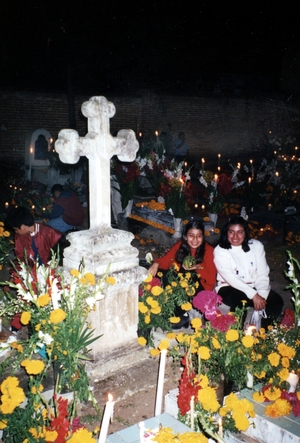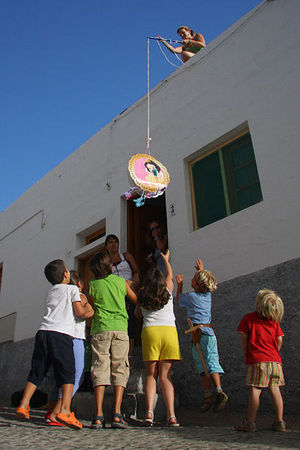Mexican exuberance takes on a special flare between October 29 and November 2nd during the Día de los Muertos or Days of the Dead celebration. It’s no coincidence that the festival falls near Halloween. When the Spanish conquered Mexico, celebrating the dead was so deeply rooted in Aztec culture that they incorporated it into their own Catholic, All Saints Day.
The indigenous peoples of Mexico believe that souls do not die but are merely resting in Mictlan (Place of the dead) just waiting to come home for one more blast with their loved ones. Día de los Muertos typically begins around the 28th or 29th of October with a trip to the market for bundles of special flowers, foods and spices. Cooking classes are held to teach the celebrants how to prepare the succulent dishes preferred by the dead (and some of the living). They include black molé chicken and Pan de Muerto (bread of the dead) anise flavored with ground cinnamon. The recipe varies but the bread is shaped like a skull or the head of the corpse, then decorated with icing and favorite items of the departed relative..
While the spirits cannot be seen, their presence is certainly felt and it behooves every family to put out their best offerings. Drinks are not overlooked either – tequila, refrescos of all kinds and atole, a traditional drink make from corn meal and water, flavored with various fruits. Mysteriously, the drinks often disappear during the night.
The Role of Lights
Lights and flowers play a significant part as well. As the spirits leave Mictlan, they disperse through the mountains and barancas on their annual getaway. In order to make their journey pleasant, relatives light candles throughout the night to help guide them home. Often entire streets are lighted with thousands of tiny votives, reminiscent of the landing runway in the movie ET.
Differing from the more somber All Saints Day, the pre-Hispanic Day of the Dead is a happy event where death takes on a friendly aspect like a joyful visit from an old friend.
Children do not see it as frightening or strange and it’s typical to see a 5-year old’s eyes light up while reaching for the skull shaped candy, declaring, “Que preciosa” (how precious).
During the early evening ritual fruit and squash are placed on the rooftops and hidden around the gardens. Teenage boy in facemasks “steal” the goodies to take home where it is cooked din a large pot and served to the participants of the all-night vigil.
Children’s’ Vigil
One of the most touching aspects is to see sleepy-eyed children arrive on November 1st for the “Vigil de Angelitos” or vigil of the little angles. Dress in their Sunday best, they have been prepared for this occasion since early childhood. The experience teaches them love and respect for the departed and awareness of their cultural roots. In little ironed dresses and shiny shoes the small girls begin the three hour vigil under the supervision of their mothers. Fathers and brothers watch from a distance as the girls carry flowers and lighted candles to the cemetery where altars have been adorned with toys made of wood or straw, favorite fruits and photographs of the departed children’s’ favorite heroes. The food for the children is less spicy than for the adults. Many traditional Mexican families believe that when a child dies they become little angles; therefore they should give up their souls with a good attitude and fireworks.
Around mid-morning the vigil of the infants is lifted, leaving the graves covered with flowers, candle wax and toys. The food is removed and the family returns home to begin preparations for the night celebration for the departed adults. In the room where the statues of the saints and virgin are displayed a family altar is constructed in the shape of a cross or the more ancient symbol of a square, bisected with spokes. The entire altar is often covered in cempazuchili (yellow marigolds, the symbol of death).
Foreign visitors are welcome
Copal incense is burned throughout the night and around midnight a bell is rung to awaken the slumbering spirits to let them know their feast is ready. The celebrants quietly proceed to the cemetery with their offerings. In silence they clean the headstones and prepare to spend the night. In higher altitudes like Oaxaca fires are lit and warm drinks are passed around as the adults begin their own all night vigil. Foreign visitors are usually welcome as long as they are respectful of the families and the tradition.
I spent such a night at the Oaxaca cemetery and it is an experience I will never forget. Literally thousands of candles flickered through out the chilly night, illuminating the faces of the families who had gathered to honor their departed, sharing drinks and stories about their loved one. The pungent smell of copal incense and marigolds hung like a blanket over the hillside cemetery. Several people offered food and drinks but turned their faces away when I tried to take a picture.
At dawn the families straggle home in small groups, leaving the cemetery with a few flickering candles. Eventually the young men come to collect the offerings and deliver them to the church or a communal distribution place. Once the spirits have “tasted” the essence of the offerings, there are plenty of live souls to devour the remaining candy skulls, soft drinks and Chicken Molé.
As the festival evolves it is amusing to see the influence of pop culture and technology: battery-operated Christmas lights, plastic floral arrangements and “Big Gulp” soft drinks take their place at the gravesite. Yet none of this seems to diminish the loves that goes into this ancient Aztec ceremony.
If you go:
Day of the Dead is celebrated throughout Mexico and in several southwestern states. Each year thousands of Mexican-Americans make the pilgrimage across the border to honor their ancestors. An increasing number of visitors from Europe, Canada and United States flock to cities like San Miguel Allende, Oaxaca and the villages along Lake Patzuaro for this unforgettable experience.
Those wishing to make the trip should make reservations in advance, especially in Oaxaca where it has become a major international cultural event. For additional information consult: http://www.day-of-the-dead.org/ and http://www.inside-mexico.com/featuredead.htm or http://www.oaxacaoaxaca.com/.
Suggested additional reading: “Through the Eyes of the Soul: Day of the Dead” by Mary J. Andrade. Published by La Oferta Review Newspaper, Inc. San Jose, CA.
Reference:
- “Through the Eyes of the Soul” by Mary J. Andrade, published by La Oferta Review www.day-of-the-dead.org/, www.oaxacaoaxaca.com.


